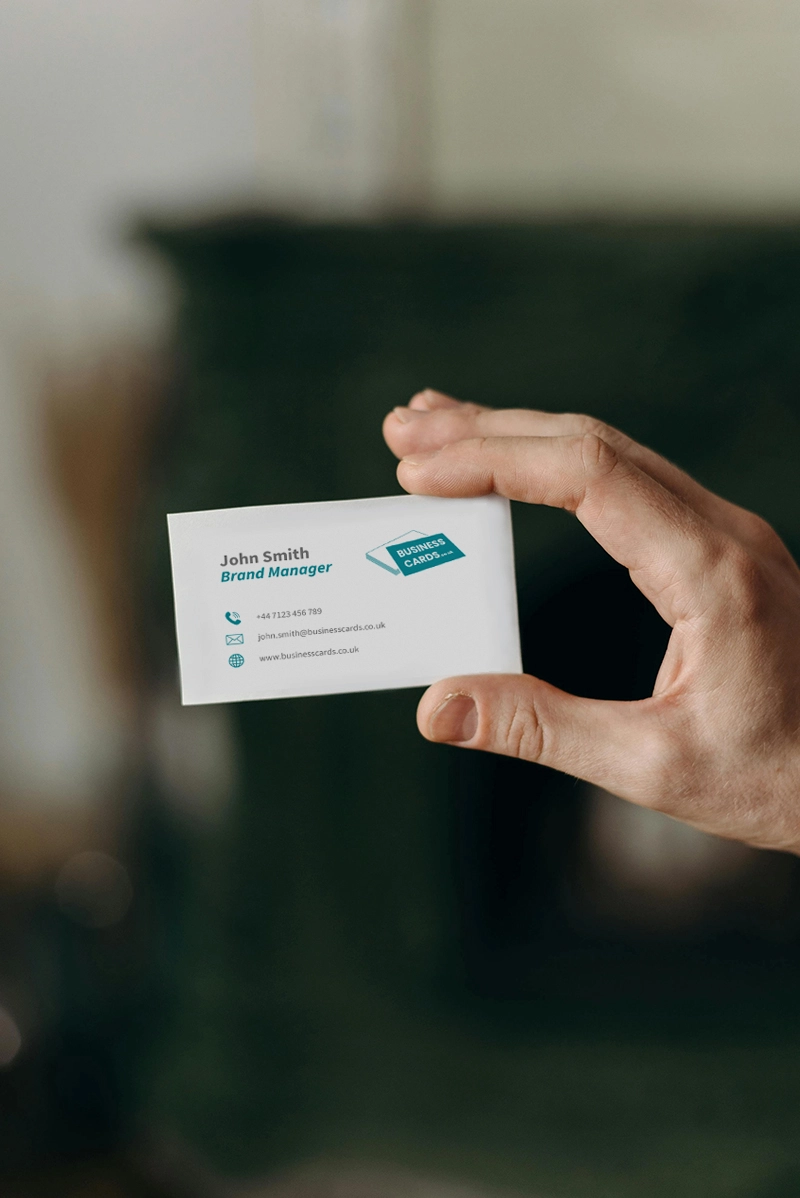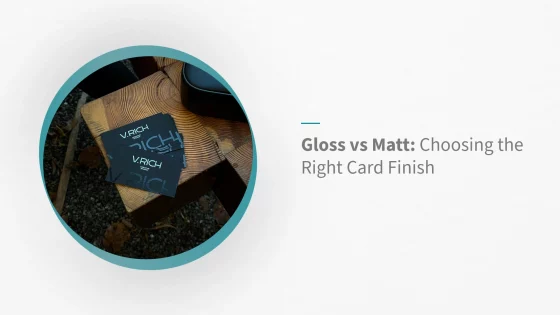Gloss vs Matt: Choosing the Right Card Finish
When printing business cards, product inserts, or promotional materials, one overlooked detail can influence how your audience perceives your brand: the card’s finish. While gloss and matt are the most common options, the right choice depends on design intent, industry expectations, and practical function.
This article compares gloss and matt finishes and introduces additional considerations like card weight and coating types—so you can select a finish that reflects your message as well as your brand identity.
Gloss vs Matt: What’s the Real Difference?
The distinction between gloss and matt is more than just shine. It affects not only appearance but also how your card feels, performs, and ages.
- Gloss features a shiny, reflective surface that intensifies colour and gives a high-impact finish. It’s smooth to the touch and eye-catching in light.
- Matt has a non-reflective surface with subtle texture. It diffuses light, improves legibility, and conveys understated professionalism.
In essence, gloss delivers visual punch, while matt offers clarity and tactility.
Understanding Paper Weight and Thickness (GSM)
Finish isn’t the only element that determines how premium your card feels—paper weight plays a crucial role. Measured in grams per square metre (GSM), weight influences thickness, rigidity, and durability.
- 300 GSM is the industry standard for business cards—sturdy enough for frequent handling but still flexible.
- 400–450 GSM is considered a premium option, offering a more luxurious, rigid feel suitable for high-end brands or executive-level presentations.
In the UK, a typical 14 pt card (approx. 0.014 inches thick) equates to roughly 300–350 GSM. If you’re aiming to impress, consider using 400+ GSM stock for an extra sense of quality and professionalism.

Why Choose Gloss Finish? Pros and Considerations
Gloss is designed for impact. The reflective surface enhances colour saturation, making bright hues pop and photographic elements more vibrant. It’s a popular choice for businesses aiming to stand out in visually competitive environments.
- Visual intensity: Bold, sharp graphics benefit from gloss’s light-reflective properties.
- Durability: Glossy coatings provide a light protective barrier against moisture and wear.
- Professional sheen: A smooth, sleek texture that grabs attention.
Drawbacks:
- Gloss can create glare, making text difficult to read under bright light.
- It is less suitable for cards that require handwritten notes, as ink tends to smudge.
- Fingerprints are more noticeable on darker, glossy surfaces.
Gloss finishes are well-suited for full-bleed images, photography portfolios, and creative industries that thrive on visual storytelling.
Why Choose Matt Finish? Strengths and Drawbacks
Matt finishes offer a refined appearance with practical benefits. The soft, non-reflective texture is easy on the eyes and ideal for readability. It’s also more forgiving when handled, making it the preferred option for cards used frequently or written on.
- Readability: The low-glare surface makes text easier to read under bright lights or natural daylight.
- Writable: Ink pens and pencils work effortlessly on matt cards, making them suitable for appointment notes or signatures.
- Resistant to smudges: Matt coatings conceal fingerprints better than gloss, especially on darker colours.
Points to consider:
- Colours may appear slightly muted due to light diffusion.
- Soft-touch matt finishes may have a higher production cost.
Matt finishes are popular for business cards, loyalty cards, corporate stationery, and any printed material where legibility and durability are prioritised.
Finish vs Coating: What’s the Difference?
While often used interchangeably, “finish” and “coating” refer to different parts of the card production process. Understanding the distinction helps ensure you select the right specifications for your project.
- Finish refers to the final surface texture and sheen (e.g. gloss, matt, silk).
- Coating is the protective layer applied to the card stock to produce that finish. Coatings can affect durability, writability, and tactile feel.
This distinction matters when combining finishes—such as applying a spot UV coating to a matt background—to enhance certain elements without compromising overall functionality.
Beyond Gloss and Matt: Other Card Finish Options
If neither gloss nor matt feels quite right for your brand, consider more advanced or hybrid finishes:
- Spot UV: A high-gloss UV coating applied to specific areas (like logos or names) over a matt surface to create contrast and texture. Common in design-forward industries that want to offer luxury business cards.
- Uncoated: No protective coating applied. Offers a natural paper feel and is ideal for writing. Often used in medical or appointment-heavy professions.
- Soft Touch: A velvety matt finish that feels high-end to the touch. Popular in boutique retail and tech sectors for its luxurious texture.
Choosing the right finish might mean combining textures for effect, or selecting a minimalist option for practicality.
Best Card Finishes by Industry
Different professions have different needs. Here’s how finish choice can align with industry expectations and card use-cases:
| Industry | Recommended Finish | Why It Works |
|---|---|---|
| Corporate / Legal | Matt or Soft Touch | Clean and professional; easy to read; understated tone |
| Design / Creative | Gloss or Spot UV | Enhances visuals and shows off design work |
| Healthcare / Medical | Uncoated or Matt | Writable surface for notes or appointments |
| Real Estate / Retail | Gloss | Bold imagery and durability during high handling |
| Luxury Brands | Soft Touch + Spot UV | Premium tactile impression with visual accents |
Real-World Perspectives & Industry Insights
Insights from UK printers and professionals highlight practical differences in performance between gloss and matt finishes:
- Matt cards are consistently preferred for high-legibility designs. The lack of glare makes text and QR Codes easier to read and scan in various lighting conditions.
- Gloss is favoured where colour vibrancy and brand recall are critical—particularly in industries like beauty, fashion, or hospitality.
- Feedback from design forums shows that creatives often opt for matt or soft-touch to showcase tactile quality and allow for note-taking during networking.
These real-world insights reinforce the idea that the best finish isn’t universal—it depends on purpose, industry, and how the card is meant to be used.

Top Tips for Choosing the Right Card Finish
- Define your card’s purpose: Is it purely visual, or do you want recipients to write on it?
- Match finish to brand tone: A modern tech company might opt for soft touch; a vibrant retailer might choose gloss.
- Consider the lighting environment: If cards are handed out in brightly lit spaces, matt reduces glare for better readability.
- Request printed samples: Physically compare gloss, matt, and hybrid finishes before finalising your print run.
- Use hybrid finishes creatively: Spot UV on a matt base can draw attention to key details like your logo or call to action.
Conclusion: Which Finish is Right for You?
There’s no one-size-fits-all finish. The best option depends on your design, how the card will be handled, and what message you want it to convey.
- Choose gloss for eye-catching visuals, rich colours, and high-impact first impressions.
- Choose matt for sophistication, readability, and practicality—especially when writing space is needed.
- Explore hybrid finishes like soft touch or spot UV to combine tactile appeal with visual highlights.
By understanding how each finish performs and feels in the hand, you can ensure your cards aren’t just attractive—but functional and memorable, too.
Ready to print cards that reflect your brand’s identity? Choose the finish that looks sharp, feels right, and leaves a lasting impression in every hand it touches.
